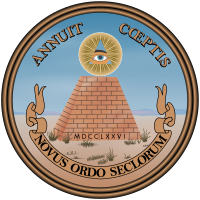Novus ordo seclorum
The phrase Novus ōrdō sēclōrum (English: /ˈnoʊvəs ˈɔːrdoʊ sɛˈklɔːrəm/, Latin: [ˈnɔwʊs ˈoːrdoː seːˈkloːrũː]; "New order of the ages") is the second of two mottos added by the secretary of the Congress of the Confederation, Charles Thomson, on the reverse (the back side) of the Great Seal of the United States (the first motto is Annuit cœptis).[1]

Origin and phrase meaning[]
The phrase is a reference to the fourth Eclogue of Virgil,[1] which contains a passage (lines 5-8[2]) that reads:
| Latin | English |
|---|---|
| Ultima Cumaei venit iam carminis aetas; | Now is come the final era of the Sibyl's song; |
| Magnus ab integro saeclorum nascitur ordo. | The great order of the ages is born afresh. |
| iam redit et Virgo, redeunt Saturnia regna, | now justice returns, honored rules return (or return of Saturn's reign); |
| iam nova progenies caelo demittitur alto. | now a new lineage is sent down from high heaven. |
The forms saecla, saeclorum etc. were normal alternatives to the more common saecula etc. throughout the history of Latin poetry and prose. The form saeculorum is impossible in hexameter verse: the ae and o are long, the u short by position.
Medieval Christians read Virgil's poem as a prophecy of the coming of Christ. The Augustan Age, although pre-Christian, was viewed as a golden age preparing the world for the coming of Christ. The great poets of this age were viewed as a source of revelation and light upon the Christian mysteries to come.[3]
The word seclorum does not mean "secular", but is the genitive (possessive) plural form of the word saeculum, meaning (in this context) generation, century, or age. Saeculum did come to mean "age, world" in late, Christian Latin, and "secular" is derived from it, through secularis. However, the adjective "secularis," meaning "worldly," is not equivalent to the genitive plural "seclorum," meaning "of the ages."[4]
The motto Novus ordo seclorum was translated and added to the seal by Charles Thomson, a Latin expert who was involved in the design of the Great Seal, as "A new order of the ages." Thomson said it was to signify "the beginning of the new American Era" as of the date of the Declaration of Independence.[1][5]
See also[]
References[]
- ^ a b c "Novus Ordo Seclorum - Origin and Meaning of the Motto Beneath the American Pyramid". GreatSeal.com.
- ^ P. Vergilius Maro, Eclogues, J. B. Greenough, Ed.
- ^ Ann Raftery Meyer: Medieval allegory and the building of the new Jerusalem DS Brewer, 2003. ISBN 978-0-85991-796-4
- ^ Lewis and Short, A Latin Dictionary: Founded on Andrews' Edition of Freund's Latin Dictionary: Revised, Enlarged, and in Great Part Rewritten by Charlton T. Lewis, Ph.D. and Charles Short, LL.D. The Clarendon Press, Oxford, 1879, s. vv.
- ^ "The Great Seal of the United States," U.S. Dept. of State, Bureau of Public Affairs, Washington, D.C., July 2003, pp. 4, 5, 15. PDF of official brochure.
- Latin mottos
- National symbols of the United States
